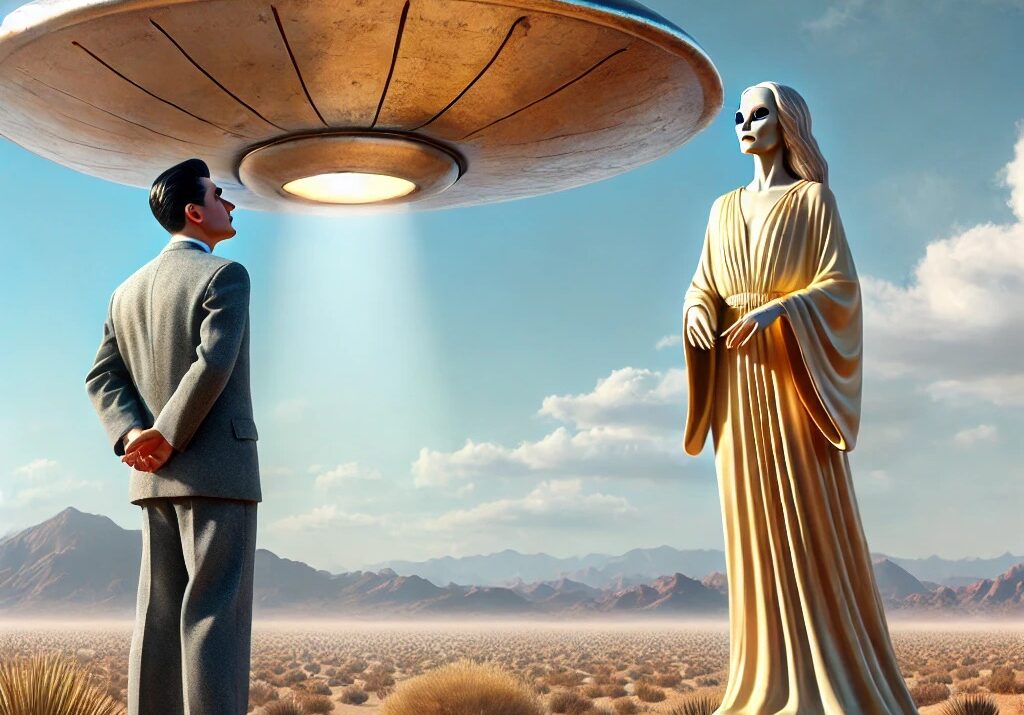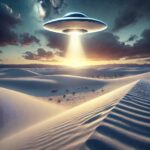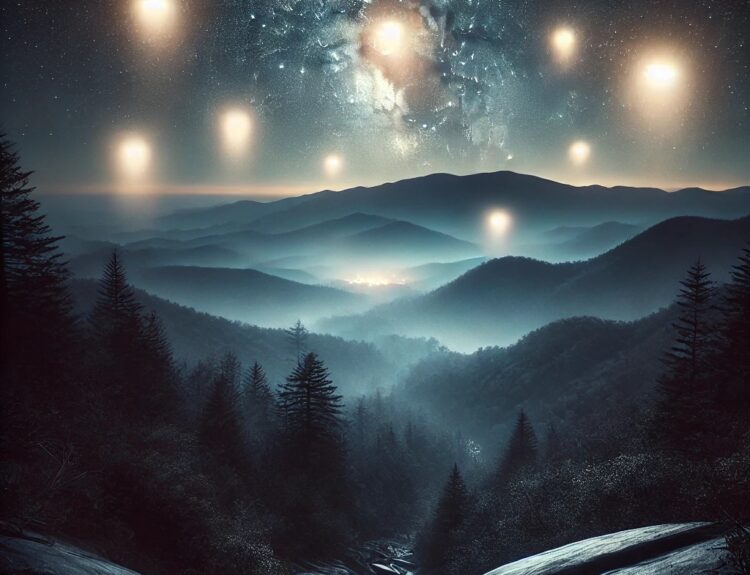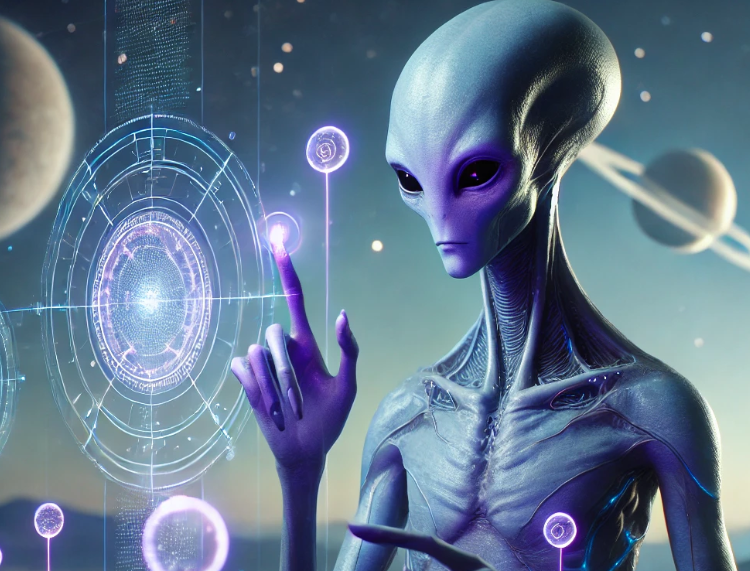George Adamski is one of the most enigmatic figures in the history of UFOlogy. His accounts of extraterrestrial contact during the 1950s played a significant role in shaping public interest and perceptions about UFOs and alien beings. Adamski, often referred to as the “father of modern UFOlogy,” claimed to have made contact with visitors from Venus, sparking both fascination and controversy. His stories of alien encounters, particularly the one that occurred in 1952, were not only detailed but also backed by other witnesses, adding a layer of complexity to the already mysterious phenomenon.
Adamski’s claims emerged during a time when the world was gripped by Cold War anxieties, and the idea of extraterrestrial life was both a source of hope and fear. His accounts were among the first to suggest that aliens were not just visiting Earth but actively engaging with humanity. This notion would later influence the development of the contactee movement, where individuals claimed to have regular communication with benevolent extraterrestrial beings. Adamski’s story is a foundational chapter in this larger narrative, and it continues to be a point of reference for UFO researchers and enthusiasts alike.
INCIDENT SUMMARY
The most significant encounter in George Adamski’s life, and arguably in the annals of UFO history, took place on November 20, 1952. On this day, Adamski claimed that he had a close encounter with a spacecraft and its occupant in the Mojave Desert near Desert Center, California. According to Adamski, the alien he met was named Orthon, a being from Venus. This encounter was not a solitary experience; it was witnessed by several individuals who accompanied Adamski on that day, lending credibility to his extraordinary claims.
Adamski’s encounter was not just a fleeting sighting of a strange object in the sky but a direct, face-to-face meeting with an extraterrestrial being. The incident began with the appearance of a cigar-shaped mothership that dispatched a smaller, disc-shaped craft to the desert floor. It was from this smaller craft that Orthon emerged. Adamski described Orthon as a humanoid figure with long, blond hair, a strikingly handsome face, and a peaceful demeanor. The encounter lasted for about 45 minutes, during which time Adamski claimed to have communicated with Orthon through a mix of telepathy and hand signals. Orthon’s message, as conveyed by Adamski, was one of peace and a warning about the dangers of nuclear weapons—a common theme among contactee narratives of that era.
This event marked the beginning of what Adamski claimed to be an ongoing relationship with extraterrestrials, particularly those from Venus. He went on to describe additional encounters and communications in his later writings, further solidifying his role as a leading figure in the UFO community. Despite the skepticism and ridicule that often accompanied his claims, Adamski remained steadfast in his belief that he had been chosen to deliver an important message to humanity.
DETAILS
- LOCATION: Desert near Desert Center, California, USA
- DATE: November 20, 1952
- TIME: Approximately 12:30 PM
- EVENT DURATION: Around 45 minutes
- NUMBER OF OBJECTS: One
- OBJECT(S) SHAPE: Disc-shaped
- DESCRIPTION OF THE OBJECT(S):
Adamski described the object as a metallic, shiny disc, approximately 20 feet in diameter. The craft had a dome on top with what appeared to be portholes. It hovered silently above the ground before descending gently onto the desert floor. - ALIEN(S) ENCOUNTERED:
One alien being, who Adamski referred to as “Orthon.” - DESCRIPTION OF ALIEN(S):
According to Adamski, Orthon was a humanoid figure, standing about five and a half feet tall, with long, flowing blond hair and a fair complexion. He wore a one-piece, brownish outfit, and his overall appearance was that of a peaceful, friendly being. Adamski noted that Orthon communicated with him through telepathy and hand signals, conveying messages of peace and warnings about the future of humanity. - CE CLASSIFICATION:
CE3 (Close Encounter of the Third Kind)
• A UFO encounter where an entity is observed, either humanoid or robotic.
• In this case, the encounter involved direct communication with an extraterrestrial being.
WITNESSES
One of the most compelling aspects of Adamski’s story is the presence of multiple witnesses who corroborated his account. These witnesses were not just casual observers but individuals who were deeply involved in the events of that day and who provided consistent testimonies about what they saw. The presence of these witnesses has been a key factor in the enduring interest in Adamski’s encounter, as it adds a layer of credibility to his claims.
- ALFRED BAILEY: Alfred Bailey, a professional photographer and a close friend of Adamski, was present during the encounter. Bailey claimed to have seen the spacecraft hovering in the sky before Adamski made contact with Orthon. He also took several photographs of the object, which later became some of the most iconic images associated with Adamski’s story. Bailey’s involvement in the incident provided visual documentation that, while controversial, remains a significant part of UFO history.
- GEORGE HUNT WILLIAMSON: George Hunt Williamson was another key witness to the 1952 encounter. Williamson was a fellow UFO enthusiast and researcher who was well-known within the UFO community for his own investigations into extraterrestrial phenomena. He claimed to have seen the spacecraft from a distance and witnessed Adamski’s interaction with Orthon. Williamson’s testimony was crucial in supporting Adamski’s account, as he was considered a credible and knowledgeable figure within the UFO research community.
- ALICE K. WELLS: Alice K. Wells, another member of Adamski’s group, was also present during the encounter. Wells claimed to have seen the spacecraft and provided additional support for Adamski’s account. Her testimony, along with those of Bailey and Williamson, helped to create a more complete picture of the events that took place on that day. Wells’ involvement in the incident also highlighted the collaborative nature of early UFO research, where enthusiasts often worked together to document and understand unexplained phenomena.
CONCLUSION
George Adamski’s 1952 encounter with Orthon remains one of the most debated and studied incidents in the history of UFOlogy. For some, Adamski is a visionary who was chosen to deliver an important message to humanity—a message of peace, spiritual enlightenment, and cosmic brotherhood. For others, he is a figure of skepticism, representing the complexities and challenges of verifying extraordinary claims. Regardless of where one stands on the authenticity of Adamski’s experiences, there is no denying the impact he had on the UFO phenomenon.
Adamski’s encounter set the stage for the contactee movement, where individuals claimed ongoing communication with extraterrestrial beings. His story, filled with vivid descriptions of alien life and technology, has inspired countless books, documentaries, and debates. It also raised important questions about the nature of evidence, the role of witness testimony, and the possibility of life beyond Earth. Today, George Adamski’s legacy lives on as a reminder of the enduring human fascination with the unknown and the possibility that we are not alone in the universe.








